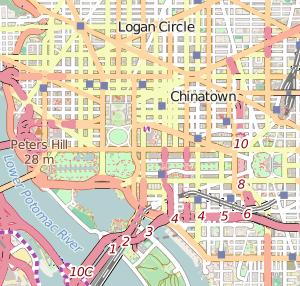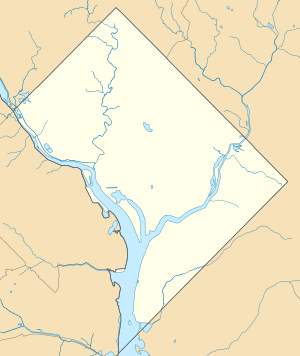Franklin School (Washington, D.C.)
|
Franklin School | |
|
| |
   | |
| Location | 13th and K Sts., NW., Washington, D.C. |
|---|---|
| Coordinates | 38°54′8″N 77°1′47″W / 38.90222°N 77.02972°WCoordinates: 38°54′8″N 77°1′47″W / 38.90222°N 77.02972°W |
| Built | 1865 |
| Architect | Cluss, Adolf |
| NRHP Reference # | 73002085 |
| Significant dates | |
| Added to NRHP | April 11, 1973[1] |
| Designated NHL | June 19, 1996[2] |
The Franklin School is a building designed by Adolf Cluss, located on Franklin Square at 13th and K Street in Washington, DC.
History
Built in 1869, the Franklin School was the flagship building of eight modern urban public school buildings constructed in Washington, D.C. between 1862 and 1875 to house, for the first time, a comprehensive system of universal public education.[1][3]
In addition to being an admired educational facility, a small plaque on its exterior describes the building's place in the history of telecommunications, noting Alexander Graham Bell's first wireless communication in 1880, where a beam of light was used to transmit a voice message using his newly invented Photophone.[4] Bell's laboratory was nearby on 'L' Street and his work was a pioneering step in optical communications, the forerunner of fiber-optic communication systems which now carry most of the world's telecommunications traffic. Bell was also a well-known educator who taught at a special day school for deaf children,[5] who trained teachers of the deaf, and who additionally created an institution for the study of deafness (also in Washington, DC).
The prominence Franklin School enjoyed was highlighted in the 1870s when studied in international expositions held in Vienna, Paris, and Philadelphia.[6] It was declared a National Historic Landmark in 1996.[2][7]
In 2002, the building was used as a homeless shelter, which controversially closed in September 2008.[8] [9] It was briefly occupied by protesters associated with the Occupy movement on November 19, 2011[10] In February 2015, Mayor Muriel Bowser cancelled the planned conversion of the school to a public facility for art exhibitions, lectures and educational activities by the Institute for Contemporary Expression. Approved by Bowser's predecessor, Vincent Gray, the project involved a privately funded conversion of the school and had its first event planned for September 2015.[11][12] As of October 2015, proposals were still being considered.[13]
Design
Cluss described its architecture as "modern Renaissance", but its origins are in the German rounded arch style, known as Rundbogenstil.[3] A bust of Benjamin Franklin adorns the building's facade. The building's Great Hall was designed to seat 1,000 people and was a resource for community concerts, exhibitions, and public meetings. Franklin is one of thirteen buildings in Washington, D.C. to receive "interior landmark protection."[6]
The location of the school in a prominent neighborhood was intended to bring attention to age-graded, separate but equal classrooms for boys and girls.[6] Offices for the Superintendent and the Board of Education were also housed in the Franklin School allowing administrators to see the benefits of the new educational system. The building also used big windows for light, roomy and airy spaces to enhance the learning environment.[14]
References
- 1 2 National Park Service (2007-01-23). "National Register Information System". National Register of Historic Places. National Park Service.
- 1 2 "Franklin School". National Historic Landmark summary listing. National Park Service. Retrieved May 10, 2008.
- 1 2 "Franklin School (55)". Adolf Cluss. STIMME.NET. Retrieved May 10, 2015.
- ↑ Moeller Jr., G Martin. AIA Guide to the Architecture of Washington, D.C. The Johns Hopkins University Press, 2006. Page 151
- ↑ NPS http://www.nps.gov/history/nr/travel/wash/dc14.htm
- 1 2 3 The Coalition for Franklin School http://www.franklinschooldc.org/
- ↑ Tanya Edwards Beauchamp and Carolyn Pitts (December 31, 1994). "National Historic Landmark Nomination: Franklin School / Benjamin Franklin Schoolhouse" (pdf). National Park Service. and Accompanying nine photos, exterior and interior, from c.1868, c. 1901, 1903, and 1995 and undated (32 KB)
- ↑ "Most Endangered Places" (PDF) (Press release). DC Preservation League. May 31, 2007. Retrieved December 4, 2007.
- ↑ Harris, Hamil R.; Stewart, Nikita (October 8, 2008). "Barry Delays Bill After Bickering Highlights Council Divide". Washington Post. Retrieved October 20, 2008.
- ↑ Klein, Allison; Craig, Tim (November 20, 2011). "Occupy D.C. protesters claim vacant Franklin School". Washington Post. Retrieved November 19, 2011.
- ↑ Kennicott, Philip (November 11, 2015). "A setback for D.C. arts and culture, years in the making". The Washington Post.
- ↑ Capps, Kriston (February 13, 2015). "Six Reasons Bowser Should Reconsider Pulling ICE from the Franklin School". The Washington City Paper.
- ↑ Clabaugh, Jeff (October 23, 2015). "D.C. receives new proposals for historic Franklin School". Washington Business Journal.
- ↑ DC Preservation League; http://www.dcpreservation.org/endangered/2005/franklin.html
External links
 Media related to Franklin School (Washington, D.C.) at Wikimedia Commons
Media related to Franklin School (Washington, D.C.) at Wikimedia Commons- Historic American Buildings Survey (HABS) No. DC-289, "Franklin School, Thirteenth & K Streets Northwest, Washington, District of Columbia, DC", 22 photos, 2 data pages